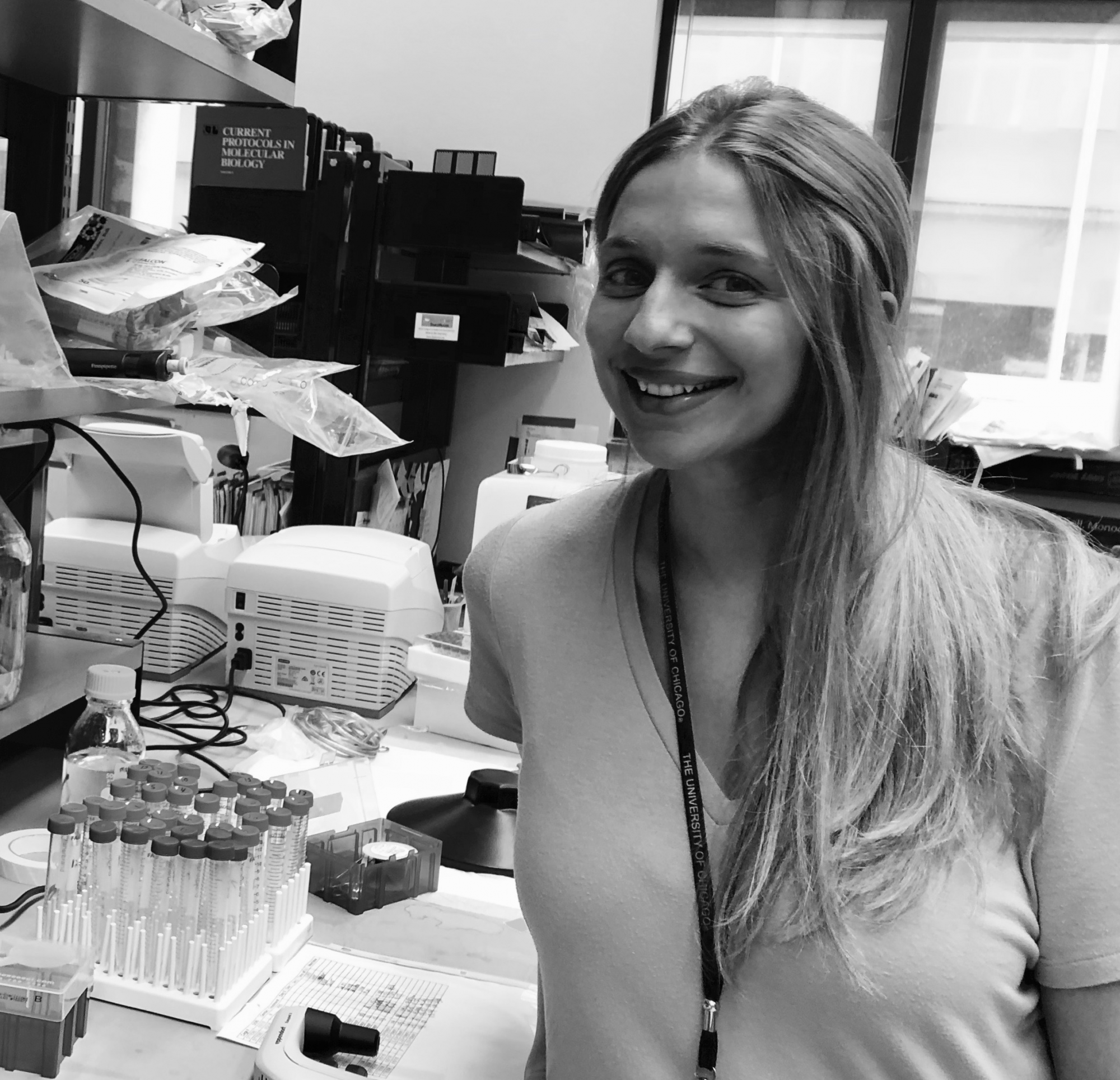August 7, 2018
RESEARCH COMPUTING CENTER
INTERNSHIP SPOTLIGHT ON AMERICAN HEART ASSOCIATION IMMUNOLOGY FELLOW
DR. PAULETTE KRISHACK
Interviewed by Sarah Kirstine Lain, University of Chicago Research Computing Center

Dr. Krishack is a postdoctoral fellow in the lab of Drs. Philip Verhoef and Anne Sperling within the University of Chicago department of Pulmonary Medicine and Immunology. She was recently awarded two years of research funding by the American Heart Association. This project will continue her advanced immunology research on the influence of type 2 and type 17 responses in inflammatory diseases.
“I like to analyze data!” I will remember Dr. Paulette Krishack by this statement (her opinion of research priorities as related to social obligation—a sentiment not uncommon to UChicago researchers). In the spring of 2018, I had the pleasure of mentoring Paulette during her MyChoice internship in “Scientific Writing and Grant Development” at UChicago’s Research Computing Center (RCC). The RCC internship supported Paulette in her grant writing and revisions, and encompassed her interests in biomedical research, big data and computational research, as well as identifying funding vehicles and review processes. I was immediately impressed by Paulette’s ambition as an early-career scientist pursuing immunology research, a feat that of course requires success in the fine art of grantsmanship. In getting to know Paulette, I quickly learned how passionate she is about her lab, and in particular: her data, a topic that often arose during our theoretical discussions of weekend “plans.” Knowing Paulette’s tenacity firsthand, I was thrilled when she informed me that her grant proposal to the American Heart Association had been awarded for two years of research funding. Such an award could not have been more appropriately granted.
INTERVIEWER
You pursued your PhD in the doctoral Molecular Pathogenesis and Molecular Medicine Program at the University of Chicago. Can you expand on how this program affected your education and research interests?
DR. KRISHACK
Initially, I applied to various graduate programs across the country with pathology, immunology, and microbiology programs. A key advantage of the Molecular Pathogenesis and Molecular Medicine Program for me was that it offered more options for young scientists. Choosing a multi-disciplinary biology program was advantageous in that I would be exposed to biomedical research in many areas of disease oriented research, including various areas of immunology. This was important to me, as I had some experience in the immunology field, but still wanted exposure to other areas. These would help me to become a more well-rounded scientist and would enable me to pursue a career path other than immunology if I chose to do so during the course of my graduate degree. It also left me open to pursuing a more specialized field of immunology (e.g., neuroimmunology).
INTERVIEWER
You also studied immunological aspects of atherosclerosis (a disease affecting the arteries) in the labs of Drs. Catherine Reardon and Godfrey Getz. During this time, you discovered that certain proteins led to lesion development during atherosclerosis in mice fed high-cholesterol diets. Can you expand on how you came to this outcome, and the potential impacts of this discovery?
DR. KRISHACK
Atherosclerosis is a type of cardiovascular disease that develops when plaque builds up in arteries; this can lead to strokes and myocardial infarctions (also known as heart attacks). Much of my PhD research focused on a protein called Serum Amyloid A (SAA), which is a secreted protein, released by the liver and macrophages. It has been suggested that SAA could be a biomarker for atherosclerosis, as it increases during inflammation. Part of my goal was to determine whether the expression of SAA led to the development of atherosclerosis– if so, how? Could it indeed be used as a biomarker? In order to explore some of these questions, my research team used a mouse model and fed the mice a high-fat, high-cholesterol diet. We found that in the absence of SAA, there was reduced lesion size and therefore reduced the development of atherosclerosis. We also found that, contrary to what we had expected, the SAA was produced locally within the lesion, within the plaque itself, and this was being produced by macrophages (a type of white blood cell). In fact, it was not the SAA secreted by the liver that led to disease development. This was surprising because the majority of SAA is produced by the liver and circulates throughout the body. While it is true that SAA can lead to the development of atherosclerosis, the levels found with the serum may not necessarily correlate to this development. You can read more about these findings in the associated publications.[1], [2]
INTERVIEWER
You were recently awarded two grants, one from the American Association of Immunologists and another from the American Heart Association. What are some of the major aims of your award, and who will be involved in the project?
DR. KRISHACK
My postdoctoral research focuses on how type 2 inflammation (i.e., asthma, allergies) influences sepsis and sepsis outcomes. Sepsis results from overwhelming inflammation; it results in response to a life-threatening bacterial infection. During this infection, the body reacts with a systemic, pro-inflammatory response in order to remove the invading pathogen. Then to counteract this inflammation, an anti-inflammatory response will develop. Unfortunately, there is a risk of death when either one of these responses occurs in excess. My research is interested in the role of a third type of inflammatory response, which may have a beneficial effect. This is the type 2 response. What happens if we induce inflammation that is typically associated with asthma or allergies during sepsis? Do people with asthma and allergies respond differently if they develop sepsis? Why? Is this preexisting type 2 inflammation a positive attribute, and do patients respond better in this case? These are the types of questions we are hoping to answer through a multi-faceted approach that will leverage mouse models, septic patients' samples, and big data analysis. I will be the primary executor of the grant, with guidance and support from my mentors Drs. Verhoef and Sperling, along with assistance from our research technician. This will involve defining the goals and outcomes of the research, determining and conducting the experiments, and publishing and disseminating the outcomes. All of this work will take place in the labs of Drs. Philip Verhoef and Anne Sperling at the UChicago Jules F. Knapp Medical Research Center.
INTERVIEWER
How has computer science and big data impacted your research, and where do you see this interplay heading in your future research? What are some of the challenges you’ve faced in data management for your work?
DR. KRISHACK
My mentor, Dr. Verhoef, performed big data analysis on nationwide databases for over 150 million electronic health records, using the Truven Health MarketScan Research Databases. Dr. Verhoef divided patient datasets into septic and non-septic groupings and found that patients who were septic were far less likely to have type 2 diseases (e.g., seasonal or food allergies, atopic dermatitis, etc.). We also found that patients with type 1 or 17 diseases (e.g., colitis, inflammatory bowel disease, type 1 diabetes, etc.) were more likely to become septic.
Moreover, our laboratory confirmed these findings in two different mouse models. These findings were published in the American Journal of Respiratory Cell and Molecular Biology. Big data analysis is definitely something that I see impacting my laboratory’s future research. In science, I think it is advantageous to combine multiple types of approaches to strengthen our understanding of diseases. As such, I believe it will become increasingly popular for investigators to combine big data analysis with analysis of mouse models and patient samples, especially as studies are becoming cross-disciplinary.

INTERVIEWER
Your long-term research interests involve understanding specific inflammatory responses during pathological diseases. What do you hope to discover with regard to these responses, and what would such a discovery mean in terms of advancing the field of immunology in broader terms?
DR. KRISHACK
My research addresses how different immune responses balance each other out—the immune responses associated with asthma (type 2), as well as immune responses associated with type 17 inflammation associated with diseases like colitis.[3] I want to understand how these different types of immune responses counter-regulate each other, and gain a better understanding of the balance of certain cell types associated with each immune response for inflammatory diseases. I am also interested in how the development of sepsis is influenced by other inflammatory diseases.
INTERVIEWER
Can you talk a bit about your process for seeking out and writing grant applications, along with the ways you've developed in your grant writing?
DR. KRISHACK
I have learned so much at this phase of my career by talking to lab mates, colleagues, and especially my mentors, Drs. Philip Verhoef and Anne Sperling. Dr. Sperling also runs a grant-writing workshop for our department, which is an invaluable resource to early stage investigators. Because of this, I have been able to have my grants reviewed and found assistance with revisions. This has also given me the ability to hear about other grants that people are working on from all different fields of the life sciences in various career stages.
INTERVIEWER
What advice would you give other immunology trainees transitioning into the independent phases of early-career research? What are some of the challenges you have had to overcome in your career development?
DR. KRISHACK
Everything is a process, especially in writing and presentations. It is so important to participate in departmental presentations, annual retreats, and national conferences. This helps reviewers to put a name with a face when you submit papers and grants. I have learned to look anywhere I can in order to get funding. In immunology, this means of course the National Institute of Health, but also the American Heart Association, private foundations, institutional resources, etc. Harness your skills for presenting research to various audiences and learn to present based on those audiences. Finally, seek out opportunities to interact with other people across the sciences, especially as they relate to computational and data science, which is becoming integral to science as a whole.
[1] Krishack PA, Bhanvadia CV, Lukens J, Sontag TJ, De Beer MC, De Beer FC, Getz GS, Reardon CA. Serum Amyloid A Facilitates Early Lesion Development in Ldlr-/- Mice. J Am Heart Assoc. 2015;4(7).
[2] Krishack PA, Sontag TJ, De Beer MC, Getz GS, Reardon CA. Serum Amyloid A Regulates Monopoiesis in Hyperlipidemic Ldlr-/- mice. FEBS Lett. 2016 590:2650-60.
[3] Krishack PA, Wang K, Rzhetsky A, Solway J, Sperling AI, Verhoef PA. Pre-existing type 2 immune activation protects against the development of sepsis. Am J of Respir Cell Mol Biol. 2017 57:628-630.